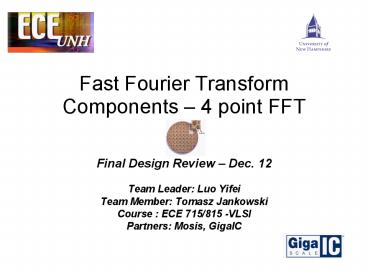Fast Fourier Transform Components
1 / 37
Title: Fast Fourier Transform Components
1
Fast Fourier Transform Components 4 point FFT
- Final Design Review Dec. 12
- Team Leader Luo Yifei
- Team Member Tomasz Jankowski
- Course ECE 715/815 -VLSI
- Partners Mosis, GigaIC
2
Presentation Agenda
Research
Methodology Specification
Design
Time Management Summary Presentation
3
Agenda
Project Definition
Design Tool Methodology
FFT Theory
Components
Design Process
Project Timetable
Summary
4
Agenda
Project Definition
Design Tool Methodology
FFT Theory
Components
Design Process
Project Timetable
Summary
5
Project Definition
- Description
- The purpose of the project is to develop a
library of components for a 4 point FFT algorithm - Specifications
- suggested clock speed 100 MHz (note if the
speed of 100 MHz can not be achieved in AMI05
technology then a lower frequency is acceptable) - algorithm radix-4
- arithmetic 16 bit fixed point, 2s complement
- complex arithmetic operations should be divided
into smaller tasks (pipelining) if the assumed
target frequency could not be achieved otherwise - All control and status signals should follow the
same standard - All components should have a clock input (CLK),
reset (RST) - Arithmetic operators should contain a status line
(OVFL) indicating whether an overflow has
occurred - The cooperation among the design teams is
encouraged!!!
6
Fingerprint Recognition Components
7
Fingerprint Recognition Components
8
Agenda
Project Definition
Design Tool Methodology
FFT Theory
Components
Design Process
Project Timetable
Summary
9
Methodology
ASIC Implementation
Step 1 Preparation
Step 2 Schematic
Step 3 Layout
Time Schedule Task Management Research Decision
Schematics Simulation Decision
Layout Padding Errors? -) Decision
10
Design tools and Methodology
- Gajski diagram
- CAD Tools
- AMI 0.5 MOSIS
11
Agenda
Project Definition
Design Tool Methodology
FFT Theory
Components
Design Process
Project Timetable
Summary
12
FFT - theory
Sixteen-point radix-4 primes-to-a-power diagram
13
FFT Complexity
- FFT 16-point radix 4 logic
14
FFT Complexity
- Points 4 -gt 16 - to complex in one chip gt 4
point (as a part of 16-point FFT) - 16bit -144 Adds16FA5Gates4tranzistors 46080
transistors!!! - Tiny Chip space for 0.50 micron AMIS 21 mm x 21
mm - Pins 40 -gt 16 inputs, 16 outputs, 2 Vdd, 2
GND, 36 - 3 control Reset, CLK, CTL
- Bits -gt 4R4I 8bits per point
- Registers 2x32 bit for input and output with
control (Real or Imaginary)
15
Agenda
Project Definition
Design Tool Methodology
FFT Theory
Components
Design Process
Project Timetable
Summary
16
Components
- FFT 4-point Complex Multiply
17
Agenda
Project Definition
Design Tool Methodology
FFT Theory
Components
Design Process
Project Timetable
Summary
18
Project Schematics
- Design components
- 4 bit Adder
- 4 bit Subtractor
- 16 bit Register
- 16 bit Output
- 4 bit Adder
19
Project Schematics
- 4 bit Subtractor
20
Project Schematics
- 16 bit Register
21
Project Schematics
- 16 bit Output
22
Project Schematics
- Whole 4 Point FFT
23
Simulation Waveforms
- 4 bit adder with Cin0
24
Simulation Waveforms
- 4 bit adder with Cin1
25
Simulation Waveforms
- 4 bit Subtractor
26
Simulation Waveforms
- 16 bit Register
27
Simulation Waveforms
- 16 bit Output
28
Simulation Waveforms
- 4 Point FFT with all Re1 and Im2
29
Simulation Waveforms
30
Layout
- 4 Point FFT
31
Agenda
Project Definition
Design Tool Methodology
FFT Theory
Components
Design Process
Project Timetable
Summary
32
Project plan
Agenda - project preparation - project
schematics simulation - layout, padding
simulations - report
33
Agenda
Project Definition
Design Tool Methodology
FFT Theory
Components
Design Process
Project Timetable
Summary
34
Next Steps
Documentation
Fabrication
Testing
35
References
1 W. Smith, J. Smith Handbook of Real-Time Fast
Fourier Transforms, JOHN WILEY SONS, 1995. 2
N. Weste, D. Harris CMOS VLSI DESIGN, A Circuits
and System Perspective, Pearson Education, 3nd
edition, 2005. 3 D. Clein, CMOS IC LAYOUT
Concepts, Methodologies, and Tools,
Butterworth-Heinemann, 2000. 4 Weste, Neil
H.E. CMOS VLSI Design, Addison Wesley, 3rd
edition, 2005. 5 M. M. Morris, C. R. Kime
Logic and Computer Design Fundamentals, Pearson
Education, 3nd edition updated, 2004.
36
Special Thanks
37
More info, links ?































